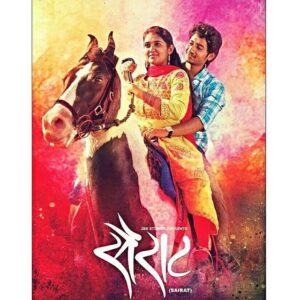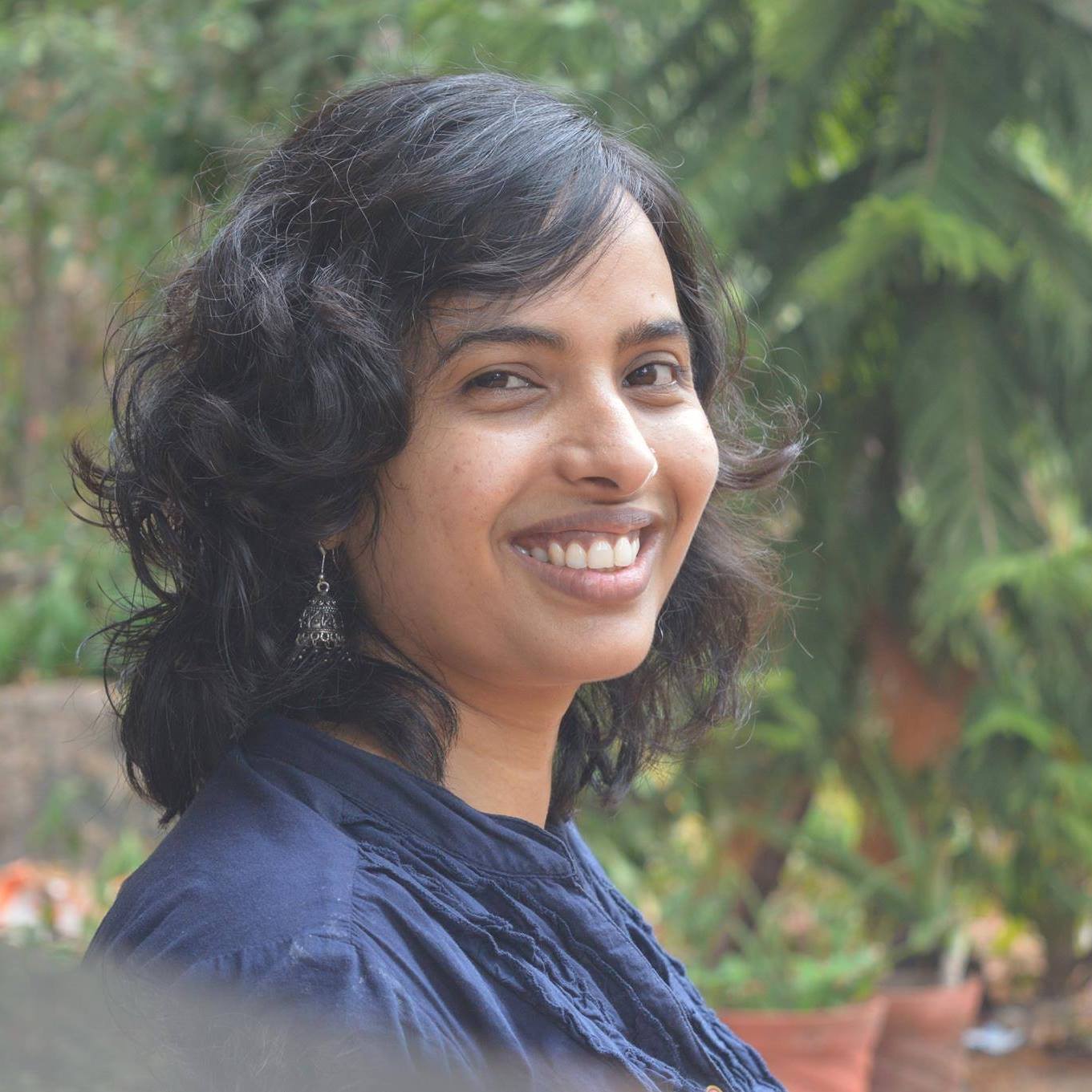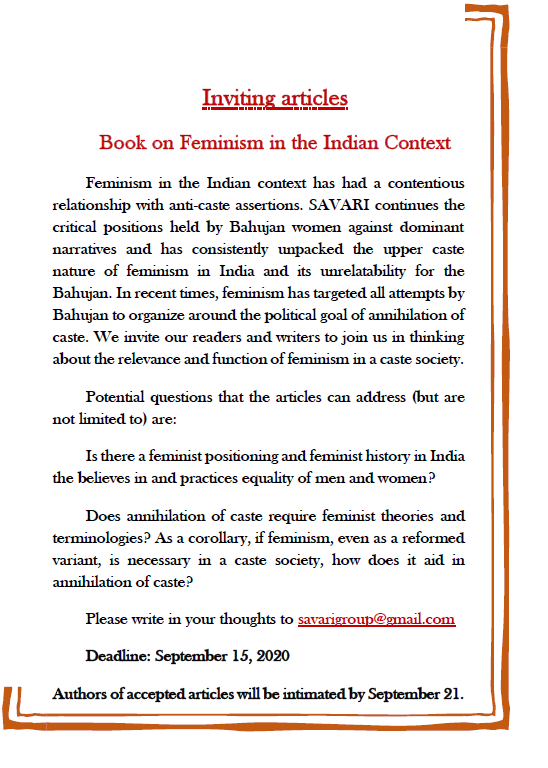Sreebitha P.V.
 Sairat (Marathi, 2016) would be the best text to examine if one is looking for the intersectionality of caste, class and gender in modern India. There have been attempts to see Archie (Archana Patil), the heroine, as transgressing the gender stereotypes or even reversing gender roles. Rather than the reversal of the gender roles, we see how caste-marked individuals perform gender differently. It’s very interesting to note how the heroine, Archie gets established in the film. In the first scene where she is introduced to us, we only have a glimpse of her from behind as the eyes of Parshya (Prashant Kale) follow her. The image of her in Salwar Kameez with neatly plaited hair, getting out of the car and interacting with the little girls presents us a rich traditional/ conventional heroine, as suggested by the costume and behaviour. The second time, Archie appears in Parshya’s dream where we see the bold heroine in a glamorous dress seducing the hero. Her dominant nature and his vulnerability are established in the same scene. The third time, we see her on horseback near the village well, as the girls there wait for her to drive away all the boys from the well and make room for them. The fourth time, we see her entering into the college riding a Royal Enfield motorbike (Bullet) and she introduces herself as Archana Patil and mentions her hobbies as swimming, watching movies, and riding Bullet. Later we also see Archie openly showing her concern and rescuing the hero from Mangya (her cousin) and warns him not to lay hands on Parshya again. She expresses her love by staring at Parshya while a class is going on and when the faculty intervenes, she warns him (the conversation later reveals that he belongs to a lower caste) through glances to mind his own business. Later we see her riding the tractor to Parshya’s home and strategically inviting him to the farm to disclose her love. His dream becomes reality as we see Archie taking the initiative for their first secret meeting on Prince’s (Archie’s brother) birthday.
Sairat (Marathi, 2016) would be the best text to examine if one is looking for the intersectionality of caste, class and gender in modern India. There have been attempts to see Archie (Archana Patil), the heroine, as transgressing the gender stereotypes or even reversing gender roles. Rather than the reversal of the gender roles, we see how caste-marked individuals perform gender differently. It’s very interesting to note how the heroine, Archie gets established in the film. In the first scene where she is introduced to us, we only have a glimpse of her from behind as the eyes of Parshya (Prashant Kale) follow her. The image of her in Salwar Kameez with neatly plaited hair, getting out of the car and interacting with the little girls presents us a rich traditional/ conventional heroine, as suggested by the costume and behaviour. The second time, Archie appears in Parshya’s dream where we see the bold heroine in a glamorous dress seducing the hero. Her dominant nature and his vulnerability are established in the same scene. The third time, we see her on horseback near the village well, as the girls there wait for her to drive away all the boys from the well and make room for them. The fourth time, we see her entering into the college riding a Royal Enfield motorbike (Bullet) and she introduces herself as Archana Patil and mentions her hobbies as swimming, watching movies, and riding Bullet. Later we also see Archie openly showing her concern and rescuing the hero from Mangya (her cousin) and warns him not to lay hands on Parshya again. She expresses her love by staring at Parshya while a class is going on and when the faculty intervenes, she warns him (the conversation later reveals that he belongs to a lower caste) through glances to mind his own business. Later we see her riding the tractor to Parshya’s home and strategically inviting him to the farm to disclose her love. His dream becomes reality as we see Archie taking the initiative for their first secret meeting on Prince’s (Archie’s brother) birthday.
Through a series of such images, the heroine is presented to us as transgressing the gender roles. But soon after the romantic song, we see them discussing their future plans. While he says he would work, she says that she would cook and wait for him every day at the door. In contrast with the projected image of her as a ‘heroine’ who apparently challenges the gender stereotype is this later image of hers, as an ‘ideal woman’ who cooks and waits for her husband. However, when the time arrives and they start living together, we see that she doesn’t know how to cook or to make tea and instead Parshya does all that for her. The bold heroine of the village becomes very helpless in the city space where, as time passes, she learns cooking and begins to work in a Frooti factory to meet their daily expenses and later becomes the manager of the same. Here Archie’s image of a woman challenging the gendered role assigned to her is made possible in her village more by her caste and class upbringing rather than through any deliberate (and ‘liberated’ attempts as touted by critics) at reversing gender roles as such.

Parshya is presented to us as an excellent cricket player at the beginning of the movie. Archie is very impressed when she gets to know that he reads, writes poems, and have scored 72% in exams. As against Archie, he is portrayed as a very innocent person. He is shy when she continuously stares at him in the classroom, he prepares food, cleans the room etc., and he helps the woman who gives them shelter both in private space and public space. He sits behind her holding the baby while Archie rides the scooty. Towards the end of the movie we also see him serving tea for her relatives as she asks him to be a good host (obviously for her upper caste relatives). All these get read as reversal of gender roles. He gets beaten up in all the fight scenes in the movie except in one scene where we see him beating up Archie in a public space. This deviation from his usual non-aggressive nature is puzzling at two levels. At one level, we can certainly see that his action is done at the behest of Archie’s father, Satya Patil, who says, ‘Never mind who is ruling your constituency, learn to “control” your women first,’ which is a dominant/upper caste ideology. In his imbibing and acting out of this ideology he is simultaneously ‘becoming’ an upper caste man’s son-in-law. However, at another level, the movie maker easily uses Parshya for a scene of violence against his wife in public following the stereotypical notion available for casting the Dalit men as violent against their women in public spaces.
Through a closer analysis of Archie and Parshya in the movie, one can read caste being performed in modern spaces through body, attitude, and comportment. On the one hand, Archie’s dominant nature, attitude, body language and loud voice tell us about the superiority of the caste and class she belongs to. On the other hand, Parshya’s vulnerable nature and attributing qualities to him such as being shy; not being strategic; knowing cooking; taking up the task of cleaning; and assuming a non-threatening posture is meant to communicate his lower caste and class status. In other words, what we see in the movie is not the gender role reversal, rather how caste-marked individuals perform gender differently in modern public and private spaces.
~~~
Sreebitha P.V. teaches at the Department of English, Central University of Karnataka.


very good article; differently interpreted the role of caste & its hidden/invisible features in the modern public and private spaces.